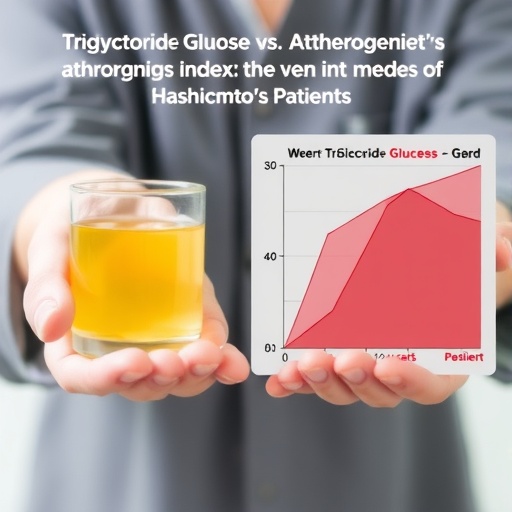In recent years, the quest to understand the intricate relationship between thyroid dysfunction and metabolic disorders has taken center stage in the realm of endocrinology. A groundbreaking study conducted by Özkan and Harı sheds light on this critical nexus, particularly focusing on euthyroid Hashimoto’s thyroiditis patients. The research examines two crucial indices: the triglyceride-glucose index (TGI) and the atherogenic index of plasma (AIP), providing crucial insights that could reshape our understanding of metabolic health in this demographic.
Undoubtedly, Hashimoto’s thyroiditis stands as one of the most prevalent autoimmune thyroid disorders, often leading to hypothyroidism and a host of metabolic challenges. Despite patients with Hashimoto’s being classified as “euthyroid” — meaning their thyroid hormone levels fall within acceptable ranges — this study reveals underlying metabolic irregularities that physicians and patients alike must address. The findings indicate that even in the absence of overt thyroid dysfunction, individuals may still experience a heightened risk of cardiovascular disease.
The triglyceride-glucose index, a relatively novel marker, offers a glimpse into metabolic status by incorporating both triglyceride levels and glucose metabolism. This index serves as a noteworthy predictor of insulin resistance, linking lipid metabolism with glucose homeostasis. In their study, Özkan and Harı found significantly elevated TGI levels in Hashimoto’s patients compared to healthy controls, raising alarms regarding their increased risk for future metabolic syndrome and diabetes.
On the other hand, the atherogenic index of plasma is another vital marker, reflecting the balance of good and bad lipids in the bloodstream. A higher AIP implies an increased risk of atherosclerosis, a condition that can lead to heart attacks and strokes. The results from this study indicate that Hashimoto’s patients show a concerning elevation in AIP, further corroborating the hypothesis that these patients are at an enhanced cardiovascular risk, even without evident thyroid abnormalities.
Furthermore, the implications of these findings extend beyond individual health concerns. This research may encourage healthcare providers to adopt a more holistic approach to managing patients with autoimmune diseases. Regular monitoring of triglyceride and glucose levels could become part of routine assessments for those living with Hashimoto’s thyroiditis, potentially leading to early interventions tailored to mitigate cardiovascular risks.
Critically, the study emphasizes the importance of early detection and management strategies rooted in metabolic health. Physicians are now encouraged to rethink how they approach the treatment of euthyroid Hashimoto’s patients, considering these individuals may benefit significantly from lifestyle modifications centered around diet and exercise aimed at improving their metabolic profiles.
The integration of nutritional strategies tailored for patients with Hashimoto’s has gained traction in recent times. Diets rich in omega-3 fatty acids, antioxidants, and anti-inflammatory compounds could help lower both triglyceride levels and improve glucose metabolism. Moreover, the adoption of regular physical activity can aid in maintaining healthy weight levels while further enhancing insulin sensitivity.
Further research is essential to fully understand the complexities of the interactions between Hashimoto’s thyroiditis and metabolic disorders. Longitudinal studies are required to assess whether improvements in the triglyceride-glucose index and atherogenic index have direct benefits in reducing cardiovascular events in these patients. Moreover, understanding genetic predispositions and environmental factors that exacerbate metabolic syndrome in Hashimoto’s patients could lead to individualized treatment approaches tailored to mitigate risks.
As the field of endocrinology continues to evolve, the implications drawn from Özkan and Harı’s research may serve as a turning point in how we view autoimmune diseases like Hashimoto’s thyroiditis. The necessity for interdisciplinary approaches that involve endocrinologists, nutritionists, and general practitioners is more crucial than ever. Patients themselves must also play an active role in managing their health through education, awareness, and taking proactive steps in their lifestyle choices.
In conclusion, the insights gleaned from the extensive research into the triglyceride-glucose index and atherogenic index in euthyroid Hashimoto’s thyroiditis highlight a significant area of concern that necessitates immediate attention. As awareness grows within the medical community regarding the metabolic implications of autoimmune thyroid disorders, the potential for improved patient outcomes through timely interventions becomes increasingly promising. Therefore, it is paramount that healthcare systems worldwide adopt these findings to enhance the quality of care delivered to those impacted by Hashimoto’s thyroiditis.
The evolving narrative regarding Hashimoto’s and metabolic health is not merely an academic exercise; it’s a matter of urgent public health. Patients must be made aware of their vulnerabilities, and healthcare professionals should be armed with the right tools and knowledge to guide them in navigating their health journeys. As we strive for a more integrated healthcare system, the implications of this study by Özkan and Harı could play a pivotal role in redefining standards of care for millions afflicted with Hashimoto’s thyroiditis.
Ultimately, this pivotal research underscores a call to action—not only to treat the symptoms of Hashimoto’s thyroiditis but also to uncover and address the hidden layers of metabolic dysfunction that can plague patients long before symptoms emerge. The interconnectedness of autoimmune conditions and metabolic health cannot be overstated, and as we look to the future, these insights will undoubtedly inform medical practices, patient education, and health policy across the globe.
Subject of Research: Euthyroid Hashimoto’s thyroiditis patients and metabolic indices (TGI and AIP)
Article Title: Comparison of triglyceride-glucose index and atherogenic index of plasma in euthyroid Hashimoto’s thyroiditis patients and healthy controls.
Article References: Özkan, S., Harı, M. Comparison of triglyceride-glucose index and atherogenic index of plasma in euthyroid Hashimoto’s thyroiditis patients and healthy controls. BMC Endocr Disord 25, 201 (2025). https://doi.org/10.1186/s12902-025-02019-7
Image Credits: AI Generated
DOI: 10.1186/s12902-025-02019-7
Keywords: Hashimoto’s thyroiditis, triglyceride-glucose index, atherogenic index of plasma, metabolic syndrome, cardiovascular risk




